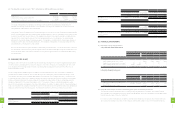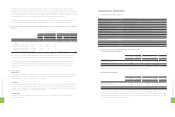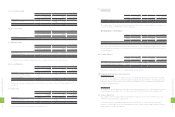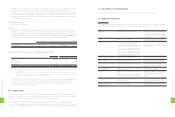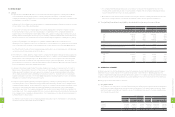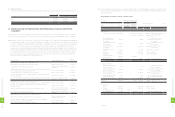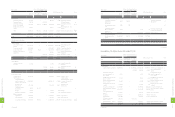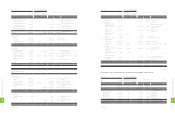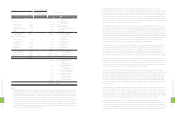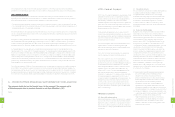HTC 2012 Annual Report Download - page 126
Download and view the complete annual report
Please find page 126 of the 2012 HTC annual report below. You can navigate through the pages in the report by either clicking on the pages listed below, or by using the keyword search tool below to find specific information within the annual report.
by NT$99,321 thousand (US$3,410 thousand) and a decrease by the same amount in "accumulated earnings." In
addition, the evaluation adjustment made on December 31, 2012 resulted in (a) a decrease in "accumulated earnings"
by NT$93,451 thousand (US$3,208 thousand) due to an increase of "accrued expenses"; (b) decreases in "cost of
revenues" by NT$5,299 thousand (US$182 thousand) and "selling and marketing expenses" by NT$4,843 thousand
(US$166 thousand) and (c) increases in "general and administrative expenses" by NT$557 thousand (US$19
thousand) and "research and developing expenses" by NT$3,715 thousand (US$128 thousand).
g) Under ROC GAAP, deferred charges are classified under other assets. Transition to IFRSs, deferred charges are
classified under "property, plant and equipment", "other intangible assets" and "other assets - other" according to
the nature.
As of January 1, 2012 and December 31, 2012, the Company reclassified NT$410,217 thousand (US$14,083 thousand) and
NT$571,485 thousand (US$19,619 thousand), respectively, of "deferred charges" to "property, plant and equipment"; and
reclassified NT$207,033 thousand (US$7,107 thousand) and NT$162,765 thousand (US$5,588 thousand), respectively,
of "deferred charges" to "other intangible assets" and reclassified NT$146,266 thousand (US$5,021 thousand) and
NT$162,914 thousand (US$5,593 thousand), respectively, of "deferred charges" to "other assets - other".
h) The Company purchased fixed assets and made prepayments, pursuant to the "Rules Governing the Preparation of
Financial Statements by Securities Issuers". Such prepayments are presented as "properties". Transition to IFRSs,
the prepayments are classified under "other assets - other". As of January 1, 2012 and December 31, 2012, the
Company reclassified NT$207,062 thousand (US$7,108 thousand) and NT$232,011 thousand (US$7,965 thousand),
respectively, of "property, plant and equipment" to "other assets - other".
i) Under ROC GAAP, if an investee issues new shares and an investor does not purchase new shares proportionately,
capital surplus and the long-term equity investment accounts should be adjusted for the change in the investor's
holding percentage and interest in the investee’s net assets. By contrast, under IFRSs, a reduction of investor's
ownership interest that results in loss of significant influence on or control over an investee would be treated as a
deemed disposal, with the related gain or loss recognized in profit or loss. An entity may elect not to adjust the
difference retrospectively, and the Company elected to use the exemption from retrospective application. The
IFRSs adjustment resulted in a decrease of capital surplus - long-term equity investments of NT$18,037 thousand
(US$619 thousand) and a corresponding increase of accumulated earnings by related rules.
j) The Company elected to reset the cumulative translation differences to zero at the date of transition to IFRSs, and
the reversal has been used to adjust accumulated earnings as of January 1, 2012. The gain or loss on any subsequent
disposals of any foreign operations should exclude cumulative translation differences that arose before the date of
transition to IFRSs. Therefore, the IFRSs adjustment resulted in a decrease in cumulative translation differences and
an increase in accumulated earnings by NT$32,134 thousand (US$1,103 thousand) each.
(3) Under IFRS 1, an entity that adopts IFRSs for the first time should apply all IFRSs in preparing financial statements
and should make adjustments retrospectively; however, the entity may select to use certain optional exemptions and
mandatory exemptions stated in IFRS 1. The main optional exemptions the Company adopted are as follows:
Business combinations:
The Company elected not to apply IFRS 3 - Business Combination retrospectively to business combinations that
occurred before the date of transition to IFRSs. Thus, in the opening balance sheet, the amount of goodwill generated
from past business combinations remains the same as that shown under R.O.C. GAAP as of December 31, 2011.
Goodwill arising from business combinations and fair value adjustments:
In accordance with IAS 21 - "The Effects of Changes in Foreign Exchange Rates", any goodwill and any fair value adjustment
to the carrying amounts of assets and liabilities arising on the acquisition of a foreign operation should be treated as assets
and liabilities of the foreign operation. Thus, goodwill and those fair value adjustments should be expressed in the foreign
operation's functional currency and should be translated at the closing rate at the end of the reporting period. The Company
elected not to apply IAS 21 retrospectively to goodwill and those fair value adjustments arising from business combinations
that occurred before the date of transition to IFRSs. Thus, goodwill and fair value adjustments that occurred before the date
of transition to IFRSs are expressed in New Taiwan dollars using the historical exchange rates.
Share-based payment transactions:
The Company elected to use the exemption from the retrospective application of IFRS 2 - "Share-based Payment" to all
equity instruments that were granted and vested before the date of transition to IFRSs.
Employee benefits:
The Company elected to recognize all cumulative actuarial gains and losses on employee benefits in accumulated
earnings at the date of transition to IFRSs.
Cumulative translation dierences:
The Company elected to reset the cumulative translation differences to zero at the date of transition to IFRSs, and the
reversal has been used to offset accumulated earnings as of December 31, 2011. Thus, the gain or loss on any subsequent
disposal of foreign operations should exclude translation differences that arose before the date of transition to IFRSs.
The foregoing optional exemptions that the Company plans to elect are subject to changes arising from the
management's consideration and assessment; thus, the actual results may vary.
(4) Special reserve at the date of transition to IFRSs
Under order VI-1010012865 issued by FSC on April 6, 2012, on the first-time adoption of IFRSs, if an entity elects to
use the exemption application specified in IFRS 1 and transfers its unrealized revaluation increment and cumulative
translation differences to retained earnings, the entity has to appropriate the sum of the increment and the differences
to special reserve. However, if the retained earnings arising from IFRSs adjustment at the first-time adoption is
insufficient, special reserve should be appropriated at the same amount by which retained earnings increased as a
result of the IFRSs adjustment. On the subsequent usage, disposal or reclassification of the related assets, the special
reserve can be reversed proportionately.
The Company elected to reset the cumulative translation differences of NT$32,134 thousand (US$1,103 thousand) to
zero and credited NT$32,134 thousand (US$1,103 thousand) to retained earnings. However, the Company's total IFRSs
adjustments, at the first-time adoption of IFRSs, resulted in a decrease in retained earnings by NT$74,837 thousand
(US$2,569 thousand). Thus, no special reserve was appropriated.
(5)
The Company has prepared the above assessments in compliance with (a) the 2010 version of the IFRSs translated by the
ARDF and issued by the FSC and (b) the Guidelines Governing the Preparation of Financial Reports by Securities Issuers
amended and issued by the FSC on December 22, 2011. These assessments may be changed as the International Accounting
Statements Board ("IASB") continues to issue or amend standards, and as the FSC may issue new rules governing the
adoption of IFRSs by companies with shares listed on the TWSE or traded on the Taiwan GreTai Securities Market or
Emerging Stock Market. Actual results may differ from these assessments. New and revised standards, amendments or
interpretations that have been issued by IASB and approved but are not yet effected by the FSC are as follows:
Standards or Interpretations Content Effective Date by IASB
IFRSs (Amendments) Improvements to 2010 IFRS July 1, 2010 and January 1, 2011
IFRSs (Amendments) Improvements to 2009 IFRS, which amend IAS 39 (see note below) January 1, 2009 and January 1, 2010
IFRS 1 (Amendment) Limited exemption from comparative IFRS 7 disclosures for first-
time adopters July 1, 2010
IFRS 1 (Amendment) Severe hyperinflation and removal of fixed dates for first-time
adopters July 1, 2011
IFRS 7 (Amendment) Disclosures - transfers of financial assets July 1, 2011
IFRS 9 (Amendment) Financial instruments January 1, 2015
IAS 12 (Amendment) Deferred tax: Recovery of underlying assets January 1, 2012
IAS 39 (Amendment) Eligible hedged items (see note below) Effective for a fiscal year ending on
or after June 30, 2009
Note: In the ROC, although the amendment to IAS 39 that was issued by the IASB in 2009 has not yet been effected by the FSC, the Taiwan
International Financial Reporting Standards ("TIFRS") is in compliance with the 2009 version of the IAS 39.
2
4
8
8
FINANCIAL INFORMATION
2
4
9
8
FINANCIAL INFORMATION



